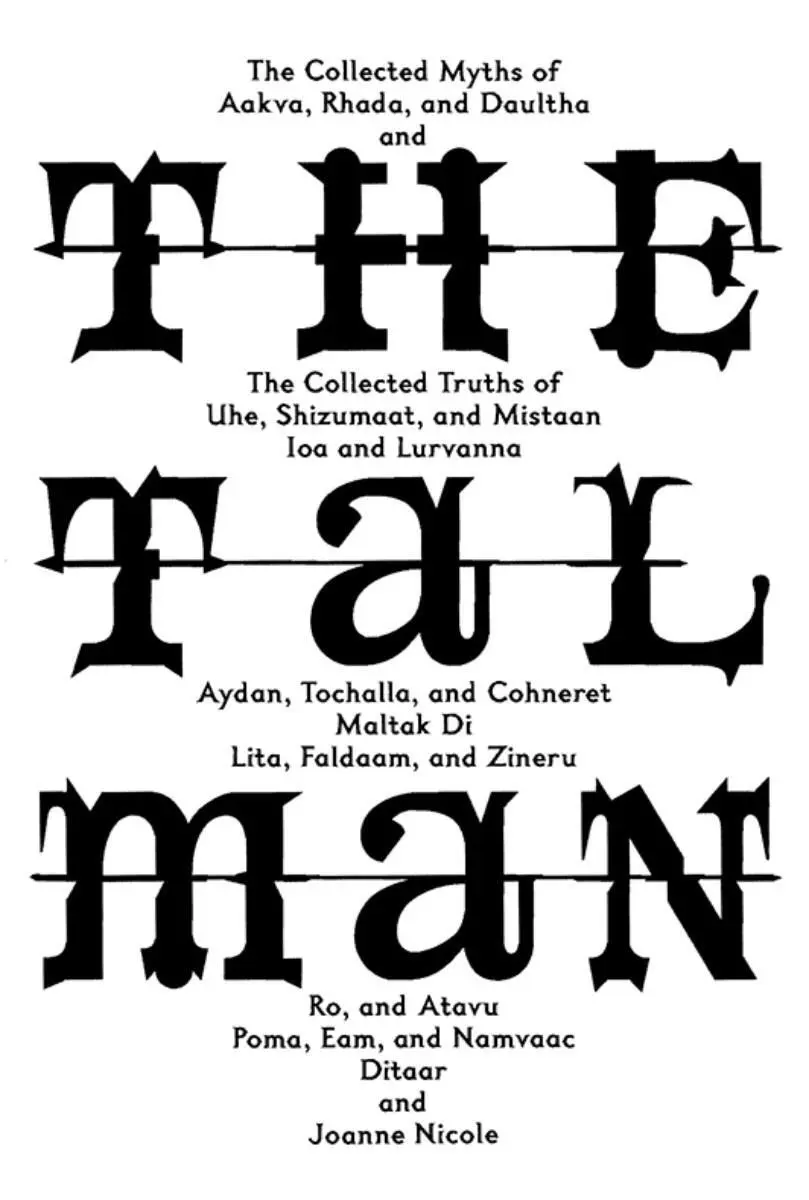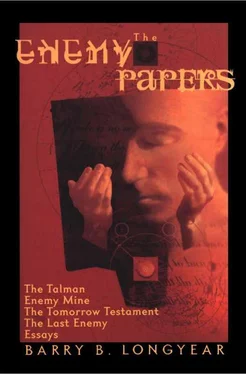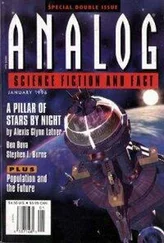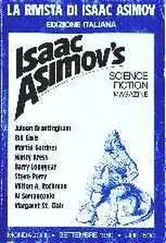Beginning with "Enemy Mine" and The Tomorrow Testament, and continuing with The Last Enemy the Enemy series spans almost the entirety of my writing career to date. There have been a lot of changes in me and in publishing since "Enemy" first appeared in 1979, but there is a strange continuity in the universe that saw three hundred worlds at war as Dracs and humans worked out the steps of their deadly dance.
I am very excited at the prospect of presenting the entire series, this time with "Enemy Mine" greatly expanded, in addition to the portions of the Drac bible, The Talman, that I was able to retrieve with my far-future fax machine.
Incidentally, the stories of The Talman have never before been published. It is a bible by aliens, set on an alien planet, about aliens and for alien readers. For the first time for readers, there is a unique choice. If you read the selections from The Talman first, you will get to read "Enemy Mine" from the perspective of a Drac. If you read "Enemy" first, you can read it from the perspective of a human.
I have included the Drac vocabulary in this volume, in addition to two very different essays. "On Alien Languages" tells some of the funny business of making up alien languages, and "Run Drac Run" tells about the origins and continuation of the Enemy series.
Three persons who deserve historical mention and grateful thanks for their suggestions and support concerning the Enemy series are George Scithers, Isaac Asimov, and Victoria Shochet. The one who deserves the most thanks for her suggestions, support, encouragement, no-nonsense discouragement when needed, not to mention putting up with the author, is Regina B. Longyear, wife, advisor, critic, and defender of the taxpayer.

The Talman was outlined and partially written as background material for the Enemy series. Although it was never intended for publication, the idea of reading an alien bible interested a number of readers, which is why I include it here, This is what I have of the work, and if enough hue and cry is raised, I might be coaxed into writing the remainder.
"The Story of Uhe" was first written, in Earth terms, about eleven thousand years ago. The origin of "The Myth of Aakva," passed down through Sindie’s oral tradition, predates it by several thousand years.
KODA SINDA
The Myth of Aakva
Sindie was the world.
And the world
Was said to be made by Aakva,
The God of the Day Light.
Aakva was said to make on the world
Special creatures of yellow skin
And hands and feet each of three fingers.
And it was said to make the creatures of one kind,
That each could bear its young,
Or the young of another.
And it was said to make the creatures
Make thought and give voice
That the creatures could worship
The Parent of All.
And it was said that Aakva
Gave its children signs and visions
That they could study,
And from them learn and obey the wishes of Aakva.
For this service,
The God of the Day Light
Was said to set upon the world
The plants and animals to feed and protect its children.
Aakva was said to set in the night sky
A star for each of its children.
Each child's star would guide its footsteps
Along the paths of right during life,
And to Aakva's side after life.
Aakva called its children the Sindie,
After the world it had made.
And the Sindie were made to walk upright
As did no other creature.
This was held to be a proof
That the Sindie were the children
Of the God of the Day Light.
The visions and signs of Aakva
Were complex and mysterious.
And it was said that Aakva charged the Sindie
To appoint servants
Who would make of their lives
The study of Aakva's messages.
The Sindie chose from among their numbers
The ones who would study
The messages of Aakva.
The servants of Aakva
Chose from among their number
A chief who would be responsible
For speaking to the Sindie
For the God of the Day Light.
The first chief was Rhada.
And Rhada had the servants
Go among the Sindie and learn
All of the signs and visions
That were known.
The servants gathered this knowledge
And gave it to Rhada.
For twelve days and twelve nights,
The chief of the servants
Studied the signs and visions,
And sorted the false from the true,
And the tribal lays
From the true Laws of Aakva.
On the thirteenth day,
Rhada spoke to the servants
Of what it had learned.
And Rhada said:
"It is truth
That Aakva is the God of the Day Light
And we are its children;
"It is truth
That the world and everything upon it
Is our gift from Aakva;
"It is Law
That violating the wishes of Aakva is tabu;
"It is Law
That the servants of Aakva
Will speak the wishes of Aakva;
"It is Law
That one who disputes a true vision from Aakva
Will suffer ordeal;
"It is Law
That one who makes false claim to a vision
Will suffer ordeal;
"It is Law
That at least one child out of three
Be made by joining
The fluid of one with the fluid of another;
"It is Law
That the one who bears the child
Is the parent of the child;
"It is Law
That the parent shall keep and provide
For the child
So long as the child is in need;
"It is Law
That the child shall keep and provide
For the parent
So long as the parent is in need;
"It is Law
That the dead are to be burned;
"It is Law
That murder is forbidden;
"It is Law
That the murderer is to be burned
With the murdered;
"It is Law
That theft from another
Or from the tribe is forbidden;
"It is Law
That the thief shall pay to its victim
In kind for its theft;
"It is Law
That to make war is to murder and steal."
And Rhada ordered the servants
To go among the Sindie
And teach the Laws.
It was promised by Rhada,
In the name of Aakva,
That as long as the Sindie listened
To Aakva's servants
And followed the laws
The God of the Day Light made,
There would be peace and plenty.
The Sindie listened to the servants and
Learned and followed the Laws.
They made sacrifice to Aakva through its servants,
And the Sindie prospered and multiplied.
Generations grew and died,
And when Summat was the chief of the servants,
One day a hunter named Daultha
Doubted the laws and the servants of Aakva.
Even as Daultha doubted,
It was said that the God of the Day Light
Watched its servants to see what they would do.
Summat ordered the servants
To bring the light to Daultha's eyes,
And the servants of Aakva scolded Daultha,
But Daultha only laughed at their anger.
Daultha was the chief of the hunt
And much admired by the tribe.
The servants of Aakva feared ordeal,
And did not challenge Daultha.
Other Sindie, seeing this,
Joined Daultha in laughing
At the laws, the servants, and
The God of the Day Light.
The servants of Aakva answered only
With silence.
Читать дальше












